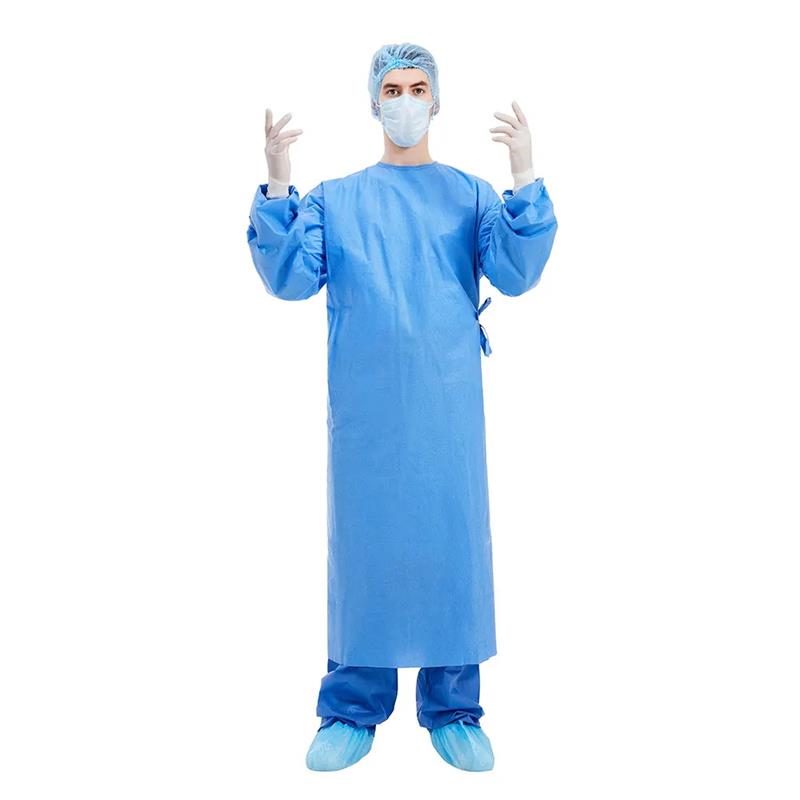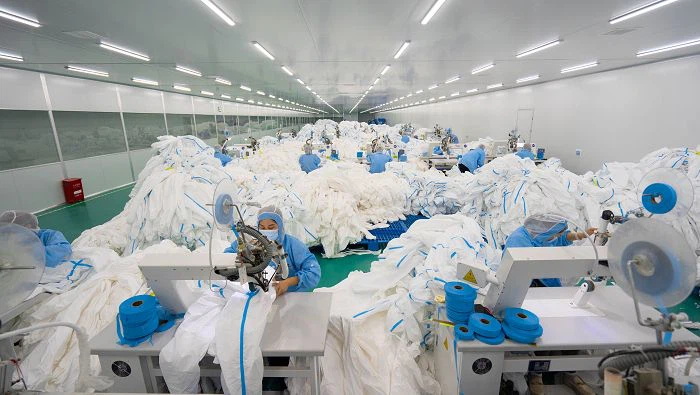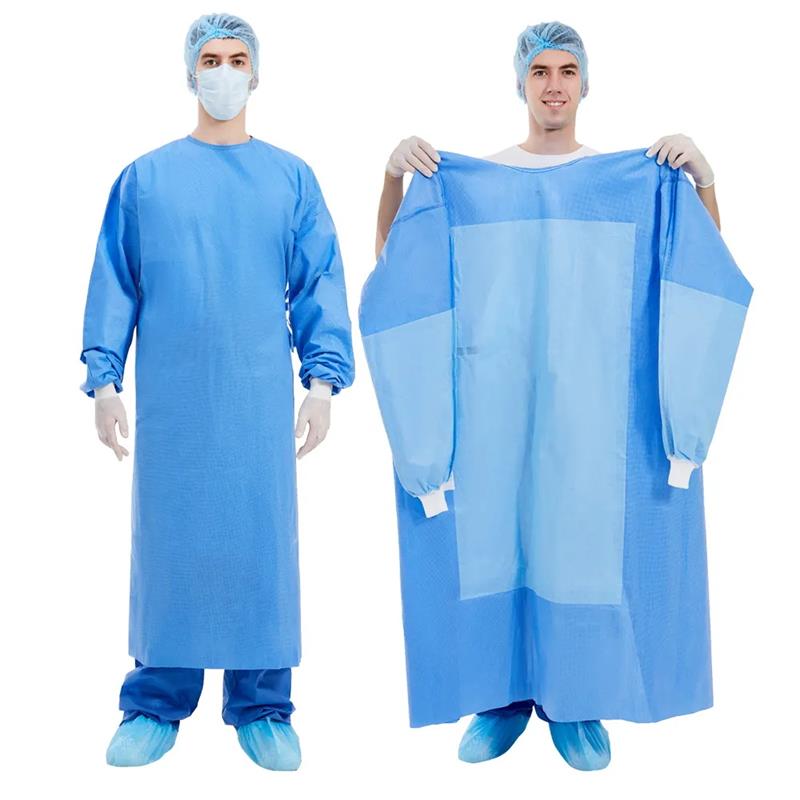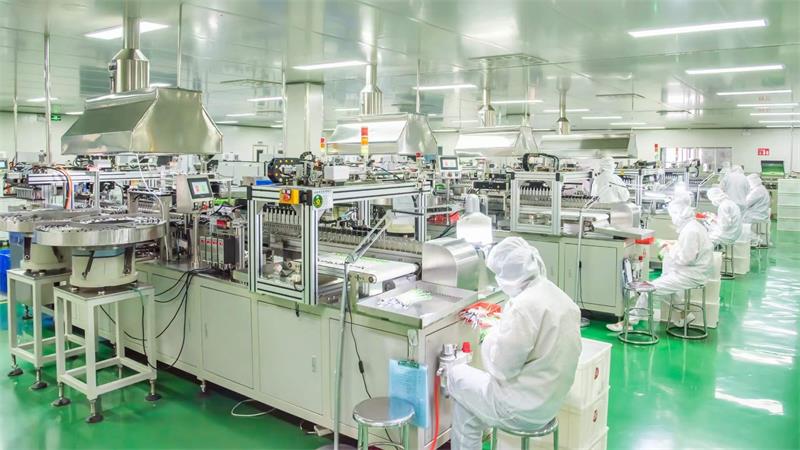Professional Surgical Gown Manufacturer & Supplier
As a leading manufacturer and supplier of surgical gowns(Reinforced Surgical Gown), we take pride in our expertise and commitment to excellence. Our extensive range includes not only surgical gowns but also isolation gowns, lab coats, protective suits, and other disposable PPE products. We understand the critical importance of safety and hygiene in medical environments, which is why our products adhere to the highest industry standards.

Product Overview:
Disposable Surgical Gown
Material: SMS(Spunbond+Meltblown+Spunbond)
Size: S(110*120cm) M(115*130cm) L(120*140cm) or customized
Weight: 45gsm or customized
Color: Blue or customized
Cuff: Elastic(knitted) cuff
Application: Hospitals, pharmacies, inspection rooms, dust-free workshops, food factories, epidemic prevention centers, etc.





Get Solution
Disposable Reinforced Surgical Gown
Material: SMS/SMMS/THREE-ANTI SMS/PP+PE
Types: Knitted cuff, with tie on waist and neck with magic sticker
Weight: 65gsm-75gsm for spun lace and 30gsm -60gsm for SMS non woven
Color: Blue, yellow, white
Usage: Hospital operation room





Get Solution
What Are The Grades Of Disposable Surgical Gowns?
In the United States, the Association for the Advancement of Medical Instrumentation (AAMI) classifies medical textile products such as surgical gowns, drapes, and isolation gowns into four levels based on their liquid barrier performance.

Level 1:
Medical textiles must undergo Impact Penetration waterproof testing, with a water penetration rate of less than 4.5 grams.
Level 2:
Products must pass both Impact Penetration and Hydrostatic Pressure tests. The former requires a water penetration rate of less than 1.0 grams, while the latter demands a hydrostatic pressure greater than 20 cm H2O.
Level 3:
Textiles at this level must have a water penetration rate of less than 1.0 grams and a hydrostatic pressure test result greater than 50 cm H2O.
Level 4:
For surgical gowns and other protective clothing, they must pass both blood and viral penetration tests. Surgical gowns and sheets must maintain their water repellency at 13.8kPa (equivalent to 140 cm H2O) for 1 minute without synthetic blood penetration. Additionally, they must undergo microbial penetration testing, ensuring no penetration of Phi-X174 bacteriophage.
How to Choose the Right Disposable Surgical Gown: A Comprehensive Guide
Selecting the appropriate surgical gown is crucial for maintaining a sterile environment and ensuring the safety of medical professionals and patients.
1. Liquid Barrier Performance:
Consider the level of liquid barrier protection needed for the specific procedure. For example, if you’re performing a surgery with minimal fluid exposure, a Level 1 surgical gown might be suitable. In contrast, for procedures involving a higher risk of fluid exposure, such as orthopedic surgeries, a Level 3 or Level 4 gown, meeting AAMI standards, offers superior protection. Assess the AAMI level based on the procedure’s requirements to guarantee optimal safety.
2. Material and Comfort:
Evaluate the gown material for comfort and breathability, especially for long-duration surgeries. Fabrics like breathable polyethylene-coated polypropylene provide both protection and comfort. Look for features like raglan sleeves and adjustable closures, ensuring ease of movement for medical professionals. For instance, reinforced surgical gowns made of lightweight, comfortable materials offer excellent protection and flexibility during intricate surgeries.
3. Customization and Environmental Impact:
Opt for suppliers who offer customization options, enabling tailored solutions for specific medical settings. Additionally, consider the environmental impact of the gown material. Eco-friendly options, such as gowns made from sustainable materials or those that can be recycled, are becoming increasingly available. Choosing environmentally conscious options not only contributes to sustainability but also aligns with global healthcare trends towards greener practices.

Innovative Protective Surgical Gowns(Reinforced Surgical Gown)
The incorporation of protective collars in these gowns ensures warmth and safeguarding for the neck area of medical professionals.
Furthermore, the inclusion of adjustable cuffs ensures a snug fit around the wrists, preventing loose sleeves and avoiding situations where gloves might slip off during surgery, exposing the hands of medical professionals.
The design of these new, user-friendly surgical gowns incorporates enhancements in critical areas. The forearm and chest regions feature double-layered reinforcement and specialized hand pockets. Reinforcement panels in these critical areas enhance the gown’s ability to resist water infiltration, thereby significantly improving safety standards.

What Are The Classifications Of Surgical Gowns?
Surgical gowns come in various categories, each designed for specific purposes and levels of protection:


Cotton Surgical Gowns: Widely used in medical institutions, these gowns are highly breathable but offer limited barrier protection. Recent advancements have integrated waterproof and anti-static features.
High-Density Polyester Fabric: These fabrics, primarily polyester-based, contain conductive elements on the surface, providing anti-static properties and enhanced comfort. They are hydrophobic, resist cotton shedding, and are often reused due to their durability. Additionally, they exhibit excellent antimicrobial properties.
PE (Polyethylene), TPU (Thermoplastic Polyurethane), PTFE (Polytetrafluoroethylene) Laminated Gowns: These gowns offer exceptional protection, and breathability, and effectively block blood, bacteria, and viruses. However, they are not yet widely adopted in many regions.
PP (Polypropylene) Spunbond Nonwoven Fabric: Compared to traditional cotton gowns, PP spunbond fabric is cost-effective and possesses antibacterial and anti-static properties. It is often used for disposable surgical gowns but has lower hydrostatic resistance and virus-blocking capabilities, making it suitable for clean environments rather than sterile surgeries.
Polyester Fiber and Wood Pulp Composite Fabrics: Primarily used for disposable surgical gowns.
Polypropylene Spunbond-Meltblown-Spunbond (SMS) Nonwoven Fabric: This advanced composite material, often referred to as SMS or SMMS, undergoes treatments for resistance to alcohol, blood, oil, static, and bacteria. SMS nonwoven fabric has high hydrostatic resistance and is extensively used in premium surgical gowns globally.
Common Questions
Most Popular Questions.
Frequently Asked Questions (FAQ) about Surgical Gowns and reinforced Surgical Gown
Surgical gowns are designed to be sterile and provide a barrier against contaminants, unlike regular gowns.
Disposable gowns are sterilized using gamma radiation, while reusable ones are sterilized through autoclaving or chemical methods.
Reinforced areas provide extra protection in critical zones, ensuring increased resistance against fluids and contaminants.
Most surgical gowns, especially disposable ones, cannot be recycled due to infection control concerns.
Yes, surgical gowns are also used in non-surgical medical procedures where maintaining a sterile environment is crucial.
Used surgical gowns, especially disposable ones, should be disposed of in designated medical waste bins following biohazard waste protocols.
Surgical gowns undergo rigorous testing for barrier effectiveness, fluid resistance, and durability to meet industry standards.
Surgical gowns, when used correctly as part of personal protective equipment (PPE), help protect against viruses, including COVID-19.
Yes, surgical gowns are used in various medical procedures outside the operating room, such as in dental clinics and minor medical interventions.
Surgical gowns are categorized by their fluid resistance levels, with higher levels indicating better protection against fluids like blood and other bodily fluids.
Surgical Gown
We would love to hear from you.
Get in touch
Leave us a message
To Get The Latest Medical Consumables Solutions
